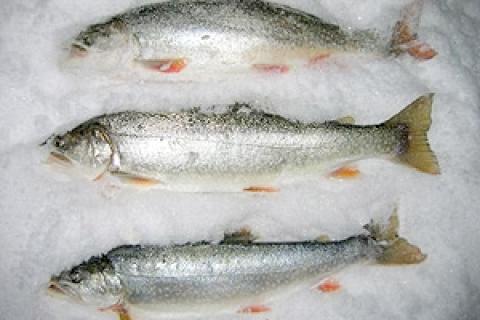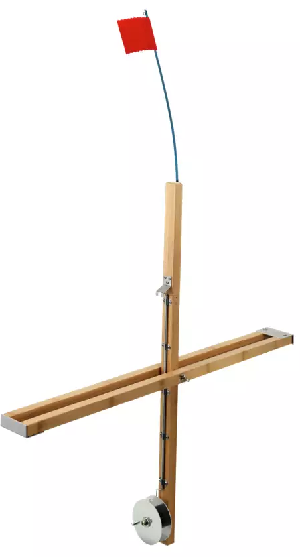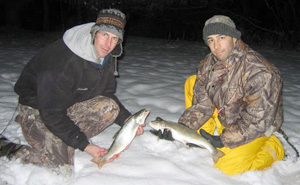
 |
| Splake are a hybrid species of trout resulting from the crossing of a female lake trout with male brook trout. |
When the rivers have become too iced up to fish and the weather is too cold to bear sitting in your tree stand, don't pack up your gear and call it a year. Simply turn to a sport such as ice fishing where the cold weather just makes things better. Very early in the winter season somewhere between the middle of December to January (depending on how cold the weather is) lakes will begin to freeze over for the first time making this an excellent opportunity to target big fish through the ice.
Almost all species of fish can be caught through the ice but elusive summer species like splake become very easy to target and catch if you are willing to risk the thin ice. Fishing for Splake is often the best during the first few weeks just after the lake freezes, and the action usually slows as winter progresses, so having the kinks worked out of your system early in the year can be the difference between a trophy and frost bite.
If you have never heard of splake, they are a man-made fish. Splake are a hybrid species of trout resulting from the crossing of a female lake trout with male brook trout. Just like all other hybrids, splake are sterile and can never reproduce in the wild essentially making them a commonly catch and harvest species. Splake have the advantage of rapid growth and hardiness as compared to other trout, and for some particular reason they readily take artificial baits through the ice.
Ice Fishing Gear Considerations
 |
| A standard lightweight jigging ice rod and reel will do the trick. |
To target splake the gear you need is relatively simple. A standard lightweight jigging ice rod and reel will work if lined with 75 feet of braided ice line and a tippet of either 8- or 10-pound test. As for your tip-ups any brand you use should work adequately, just make sure that one you decide to use is free of rust, and other debris that can interfere with a trophy spooling out your line.
A selection of various colored marabou jigs and jigging spoons such as the Swedish Pimple will be necessary. Marabou jigs in yellow, white and black seem work the best for trout, but in clear water conditions a properly-jigged silver pimple can attract attention from even the most lackadaisical of fish. An 8-inch power auger would make the job of drilling holes a lot easier, but a hand auger will do the job just fine seeing as the ice you will be fishing is not going to be that thick during this time of year. As far as bait goes any 1 1/2- to 2-inch baitfish should do just fine. Splake are very opportunistic feeders and most will not have much of a problem inhaling jumbo minnows. Nightcrawlers can be another good choice for ice anglers looking to target splake. Tipping ice flies or jigs with the crawlers is a good way to get the fishes attention while at the same time giving you a chance to catch almost anything else that swims.
Having an ice shanty and portable heater can make life out on the ice trouble-free especially during very cold weather. Small portable shanties are relatively cheap and nowadays can be dragged, set up and taken down with barely ever breaking a sweat. If you are planning being out for more than just a couple of hours or if you are planning on fishing a big lake then a good shanty is a must.
Additionally an 8 inch power auger makes the job of cutting holes in the ice a whole lot easier but a hand auger will do the job just fine seeing as the ice will not be the thick during this time of year. A portable fish finder is needed if you plan on splake when they go deep. You should be able to see big fish move across your graph certain depths then simply drop your bait you are in the range where the fish will find it. If you don't have a fish finder, talk to people to find likely spots. It is a good idea to watch for signs that other anglers have been fishing in your area like a concentration of old holes or signs that fish have been caught.
Fishing Techniques
 |
| Keep a few tip-ups set up behind you in the shallows just in case a few fish move through late in the day. |
With first ice splake, anglers do not need to go out too far from shore to find fish. In most cases anglers can find fish between 4-8 feet of water cruising a few feet under the ice looking for a quick meal. The first few hours of daylight are usually the most productive for splake so having your lines in the water early pays off. A good way to begin is to start out drilling a few holes shallow and progressively work your way deeper until you find the fish. After you have jigged for a while in the shallower water keep a few tip-ups set up behind you in the shallows just in case a few fish move through late in the day. Set these shallow tip-ups about halfway down in the water column and make sure that your minnow stays active. In most cases the bigger splake stay in deeper water (20-50 feet) will stay near a transition from shallow to deep water. Place a couple of tip-ups two feet off of the bottom and the remainder about 3/4 of the way down in the water column.
Jigging your bait occasionally can increase your productivity and making sure your lines are always baited with live minnows also increases your odds. When jigging try two different approaches: first a slow, almost motionless presentation and a more aggressive twitching action. With the slow approach use short, gentle movement; raising your rod a foot or so and then lowering it. Make sure your lure comes to a complete stop before repeating the movement. With the aggressive approach, twitch and shake the jig to make it dance throughout the water column. Use irregular movements combined with short pauses to get the attention of fish passing near by. Once a fish does bite or take your tip-up set the hook and be ready for a fight. Like all other trout splake will run hard under the ice trying to throw the hook and run free so keeping tension on the fish at all times is a necessity.
Ice Considerations
 |
| Splake are a unique trout species that most anglers never get a chance at catching. |
As much as we all love pulling fish through the ice, we have to remember that no splake is worth taking a plunge into freezing cold water for. A safe 4 inches of new clear ice is the minimum thickness for anglers walking on the ice while 5 inches is the minimum for snowmobiles and ATVs. As the winter progresses 8 to 12 inches of ice should be adequate for cars or small trucks. Always remember that these ice thicknesses are merely guidelines for anglers to follow and no thickness of ice is absolutely safe to walk on.
Although the coming of winter might leave a sour taste in the mouths of some outdoorsman, many ice fishermen know that this coming of winter means some of the best fishing opportunities of the year. Splake are a unique trout species that most anglers never get a chance at catching but the icing over of lakes gives anglers the opportunity of catching a trophy fish. Get out your warm coat and woolly socks and spend a day hanging your line through the ice and see what is wandering below.
- 16157 views

